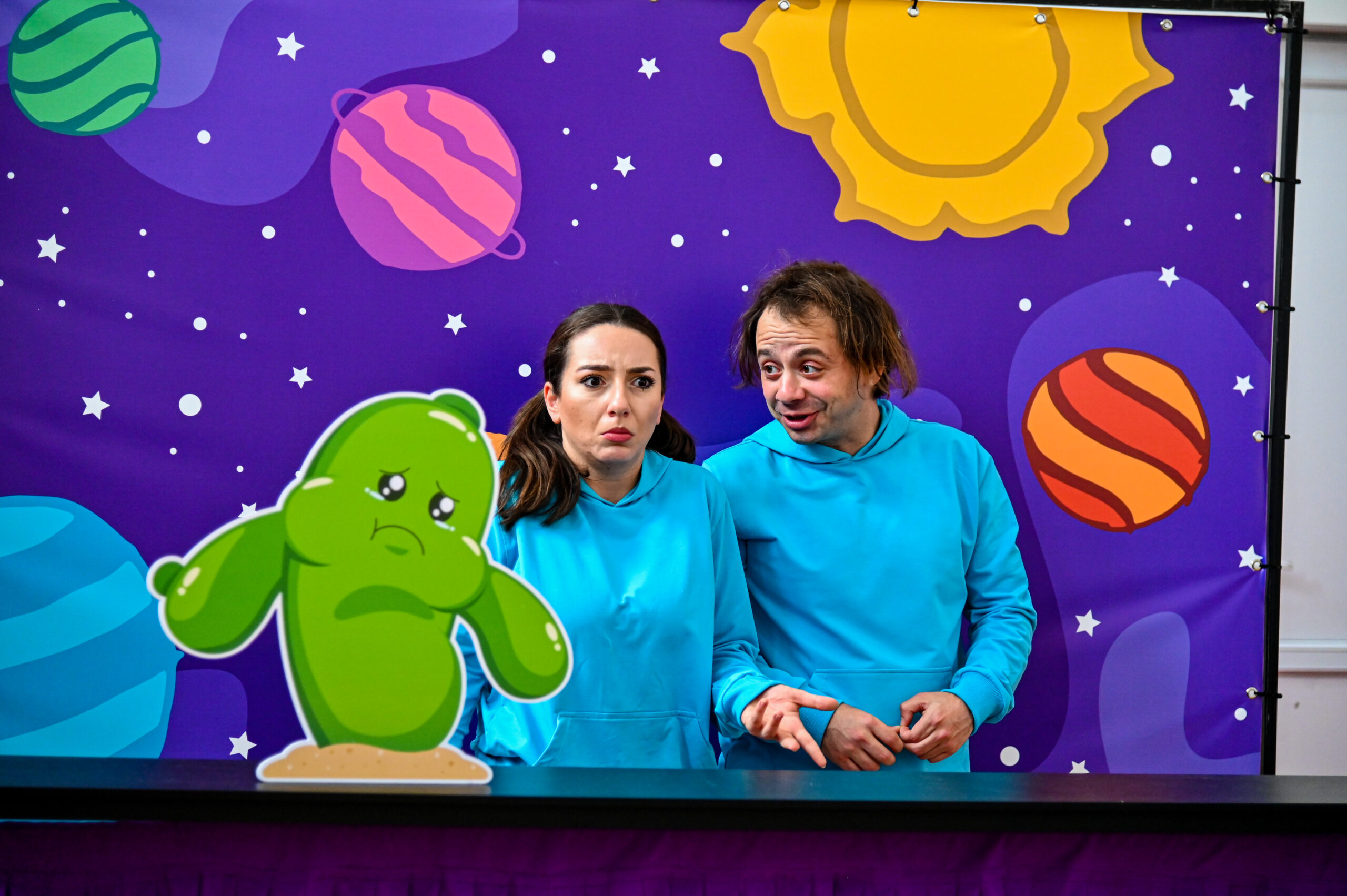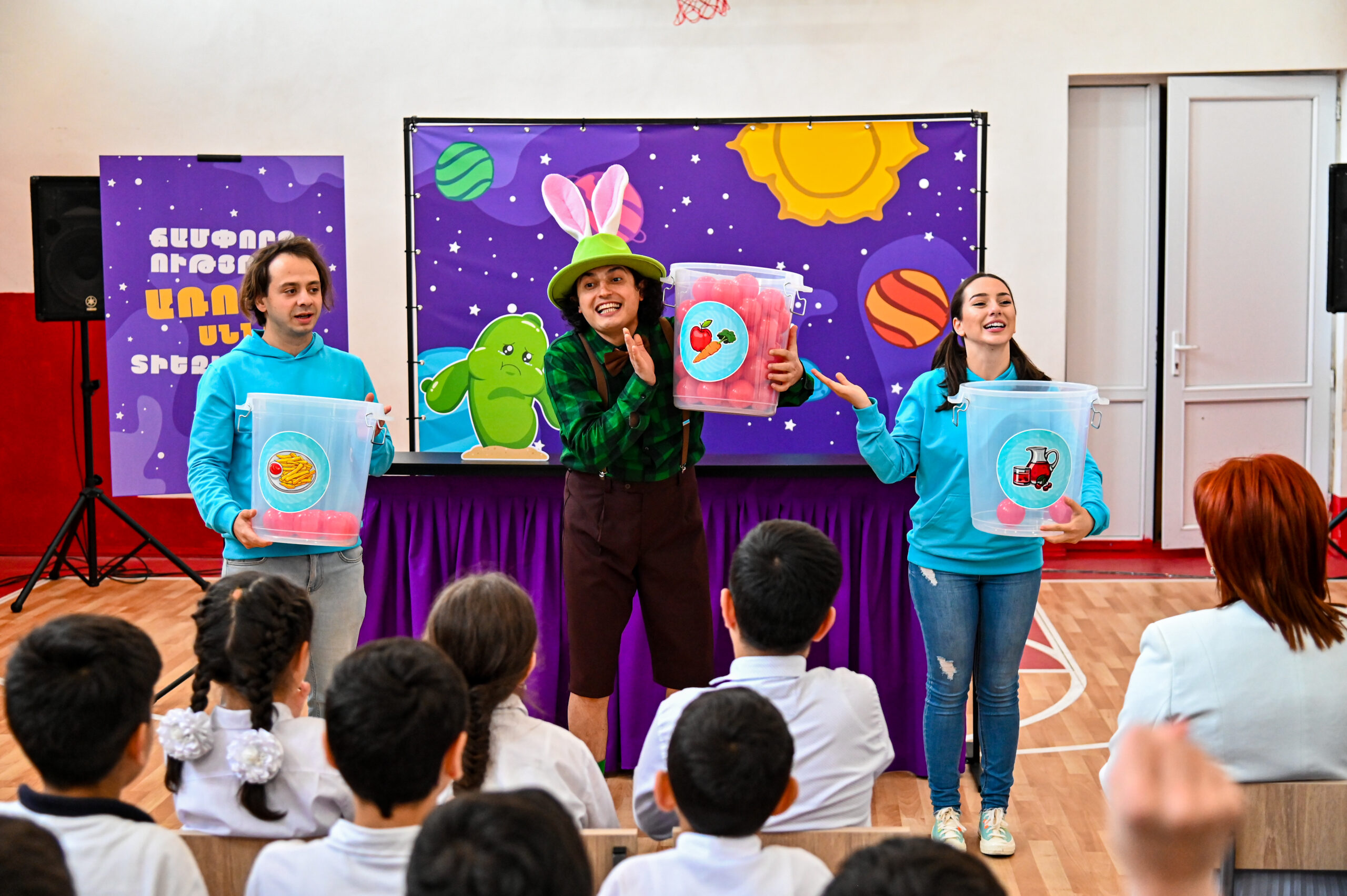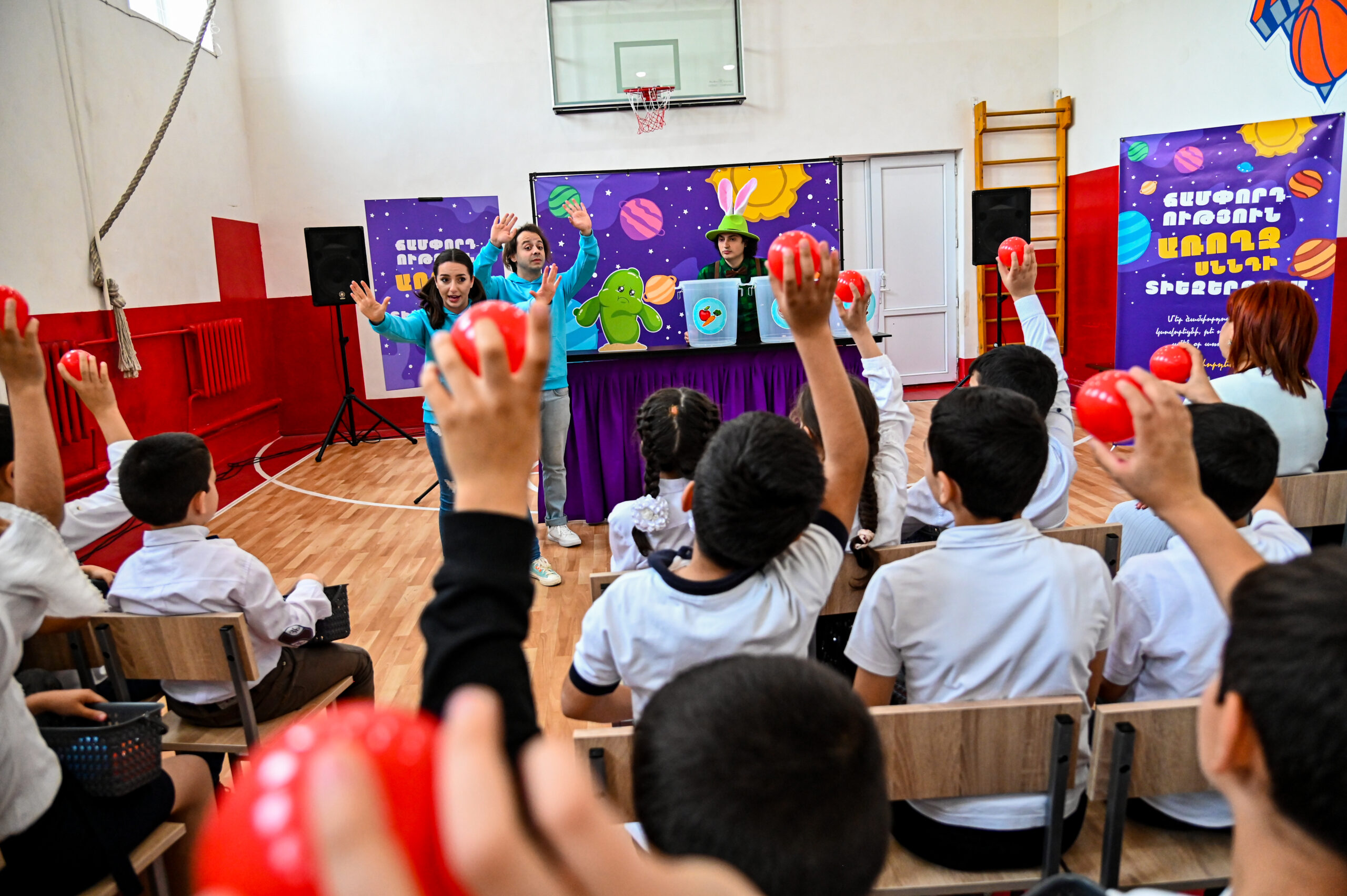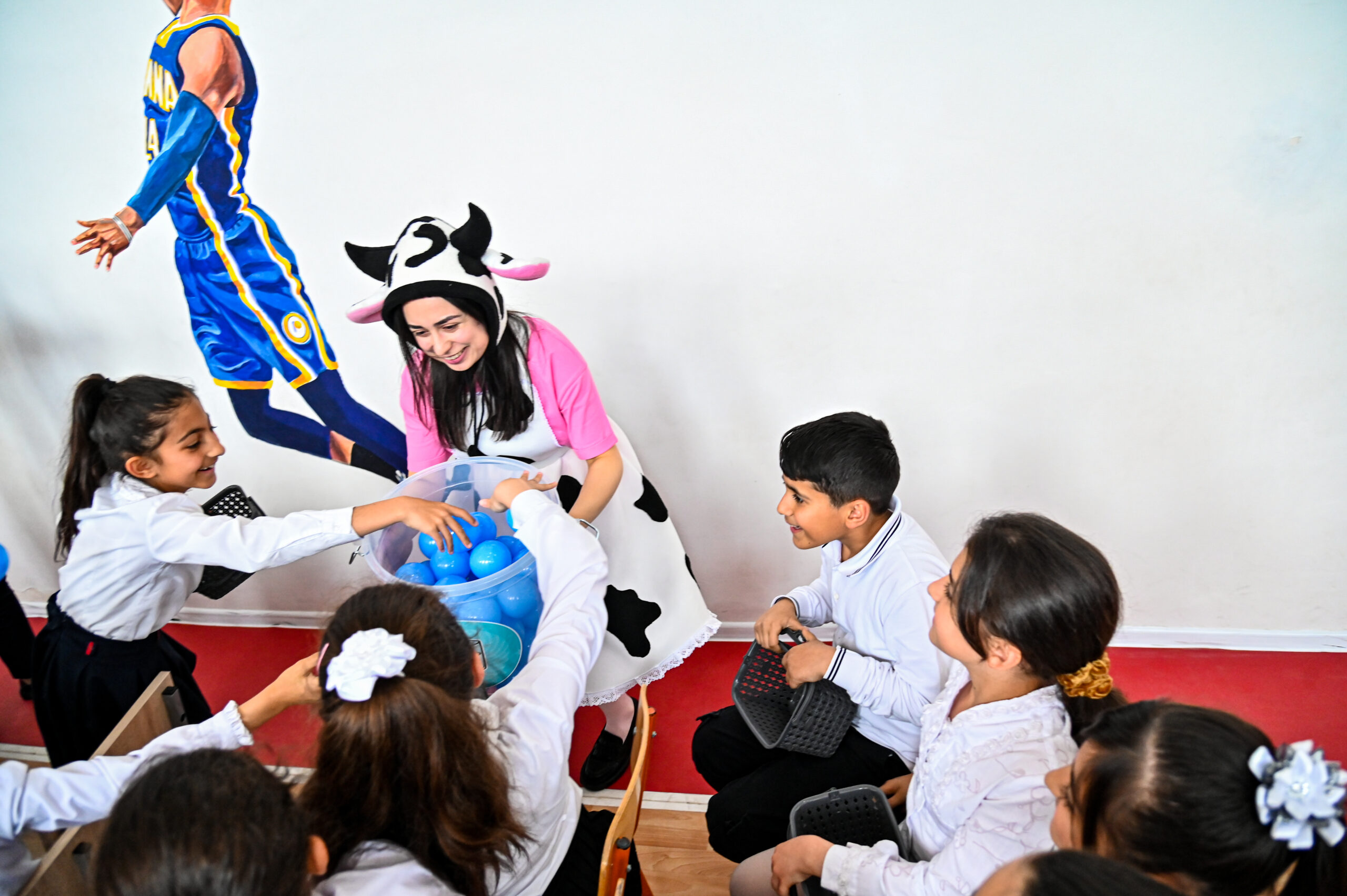“Space Travel to Health: An Interactive Performance to Make Schoolchildren Friends with Healthy Eating”
Thornless cactus? It’s quite possible if the queen of deserts isn’t eating healthily, consuming fast food every day: chips, cola, and burgers. But don’t worry, it can be restored to its sharp thorns and its former irresistible charm. In any case, Ani and Hayk embark on a space trip to discover and help their friend find thorns and regain good health. The interactive performance titled ‘Journey in the Universe of Healthy Food,’ developed by the initiative of SFCW (School Feeding and Child’s Welfare Agency), is a space adventure designed to acquaint children with healthy eating.”
“Through performance, we interpreted and conveyed the concept of a ‘healthy plate’ to the children in various ways. Specifically, the four planets symbolize the four main components of a healthy plate, and the space policeman emphasized the importance of physical activity,” says Satenik Mkrtchyan, Director of the “School Feeding and Child’s Welfare” Agency.
The “School Feeding and Child Welfare” Agency is not solely involved in supporting program implementation and developing the capacities of various stakeholders. The institution’s overarching vision is to propagate the concept of healthy eating among schoolchildren and their parents, ensuring that the foundation for a healthy future for children begins with habits instilled both at school and at home. In line with this ethos, the agency has initiated the development of an interactive performance aimed at educating children about the significance of healthy eating through an engaging, adventurous, colorful, and educational format.”
“Mrs. Mkrtchyan highlights the necessity for a theater by pointing out that while educational efforts were underway with parents, cooks, and directors, the crucial involvement of the students remained overlooked.
The Agencies’s monitoring team, consistently visiting schools to assess program implementation, has documented prevalent issues. They have encountered resistance to certain aspects of the program, often necessitating explanations for menu choices such as reduced salt or absence of sugar, among other concerns.”
“In this context, the chefs emphasized the significant work needed directly with the children. This realization acted as a catalyst for us to take action,” explains Satenik Mkrtchyan. “Our best approach to engage them was through vibrant expressions and the use of art. It was like hitting ‘two birds with one stone’—creating a celebration while imparting essential knowledge. Thus, the idea of a theater event for children emerged.”
“The ‘Theatre of Changes,’ a public organization, added a cosmic touch to this concept. They developed the play’s script and brought it to life, transporting the characters into the galaxy of healthy eating. When Hayk Sekoyan, the founder and creative director of ‘Theatre of Changes,’ was approached to create a performance centered on healthy food, he had no hesitation about its potential success. For 15 years, Hayk’s organization has effectively implemented informal educational programs through interactive performances.”
“From a professional standpoint, we were deeply intrigued by the concept of using theater as a medium to address the topic of healthy eating,” Hayk explains. “Prior to delving into the script, extensive research was conducted to grasp a comprehensive understanding of the play’s focal points. The nutritionists from the “School Feeding and Child Welfare” Agency played a pivotal role, collaborating with us through various stages to revise, modify, and finalize the script.”
The educational performance was crafted around the themes found in Antoine de Saint-Exupéry’s “The Little Prince.” Protagonists Ani and Hayk embark on a space journey in their spaceship but find themselves stranded in the desert due to a malfunction. There, they encounter a forlorn and debilitated cactus, its thorns having withered away due to numerous illnesses brought on by an unhealthy diet.
“Our aim was to creatively illustrate to children the distinction between healthy and unhealthy food choices,” the screenwriter explains. “We endeavored to depict the consequences of unhealthy eating in an engaging manner, contrasting it with the positive outcomes of a nutritious diet. The first, embodied by a thornless, despondent cactus, and the latter portrayed through a rejuvenated, biologically active cactus that has regained its thorns.”
Grigor Ghapantsyan Primary School No. 4 in Ashtarak proudly hosted the inaugural interactive performance. Choosing this school as the venue for the vibrant showcase on healthy eating was an easy decision, especially considering the recent renovation of the school canteen, which now aligns with the “Hot Meal” aspect of the “School Feeding” program. This upgrade ensures that the 300 elementary school students at the institution will relish nutritious and delectable meals starting from the new academic year.
“It was fascinating to witness how children perceive their beloved treats, like ice cream, realizing the significant sugar content and its impact on health,” shares Satenik Mkrtchyan, who attended the play’s premiere. “We aren’t too strict with the children; in fact, within the same performance, we provide a healthier alternative to ice cream.”
Ani and Hayk embark on an educational space journey, accompanied by Thornless Cactus, exploring four distinct planets: Dairy Planet, Fruit and Vegetable Planet, Cereal Planet, and Protein-Rich Planet. Along their voyage, they encounter diverse characters, engaging children in interactive games to gather all the components for the “Healthy Plate” tailored for Thornless Cactus. Their adventure also includes a vigorous workout with the space policeman, teaching them that a balanced diet alone isn’t sufficient for good health—physical activity is equally crucial. Returning Thornless Cactus to its native desert from the cosmic expedition, Ani and Hayk, armed with newfound knowledge about healthy eating, witness the rejuvenation of its sharp thorns.



The “key” of the performance lies in its interactive nature. Children, the audience themselves, are not passive spectators; instead, they are active participants, decision-makers, integral parts of the performance.
“When a child has the chance to actively engage, boredom becomes unlikely as they are involved in resolving specific issues, and their voice holds significance,” explains Hayk Sekoyan. “In this particular performance, the revival of Cactus relied on everyone’s contribution. As a norm, the children consistently made the right food choices. I observed them from within their midst and witnessed their complete immersion in the play’s storyline. Whenever another character placed the star buckets on the table, they enthusiastically engaged in animated discussions, deliberating over the food choices. Their anticipation was palpable as they eagerly awaited the outcome to see if their selections were correct.”
The screenwriter breathes a sigh of relief stating about receiving feedback from the children. Despite harboring no doubts about the success of the performance, engaging an audience of children isn’t without its challenges—they express their satisfaction and dissatisfaction with unfiltered honesty.
“The premiere functions as the primary rehearsal for the performance,” Hayk explains. “That’s why we conducted our main rehearsal at Ashtarak school No. 4. And why is it the primary experience? Well, because children aren’t merely passive observers; they’re active participants in the performance, and we hadn’t yet encountered that dynamic. (Smiles).”
Hayk mentions that a specific term was coined for these interactive theater events: theater education ( թատերային ուսումնազվարճանք).
Years of experience have convinced them of the effectiveness of this unique form of informal education. Similar performances serve as a direct, effective, and unmistakable way to convey the intended message.
“The role of emotions in the educational process is highly significant, and theater encompasses a spectrum of emotions: fear, joy, excitement, surprise,” the screenwriter explains. “Information infused with emotions has a much deeper impact from an educational standpoint than, for instance, a traditional classroom lecture. In this performance, children will remember their choice of healthy food and practically apply it in their lives.” The “School Feeding and Child’s Welfare” institution earnestly desires to perform this play in as many schools and for as many students as possible, but this goal hinges on financial resources.
“The cost of one interactive theater performance isn’t exorbitant. We’re seeking individuals who align with our vision of fostering healthy children to support this project as donors, enabling us to reach as many children as we can, taking them on a journey through the realms of healthy eating,” they express.


Additionally, the “School Feeding and Child’s Welfare” Agency plans to share the play’s script, props, and guidelines with schools. This initiative aims to encourage their theater groups to stage it on-site, integrating the play as an anticipated element of school events and spreading awareness about healthy food to as many children as possible on a positive note.
Under the guidance of a professional director, high school students from Gyumri school No. 15 have already successfully staged the performance. The “School Feeding and Child’s Welfare” Agency supported the school by hiring the director and providing props for the performance.
